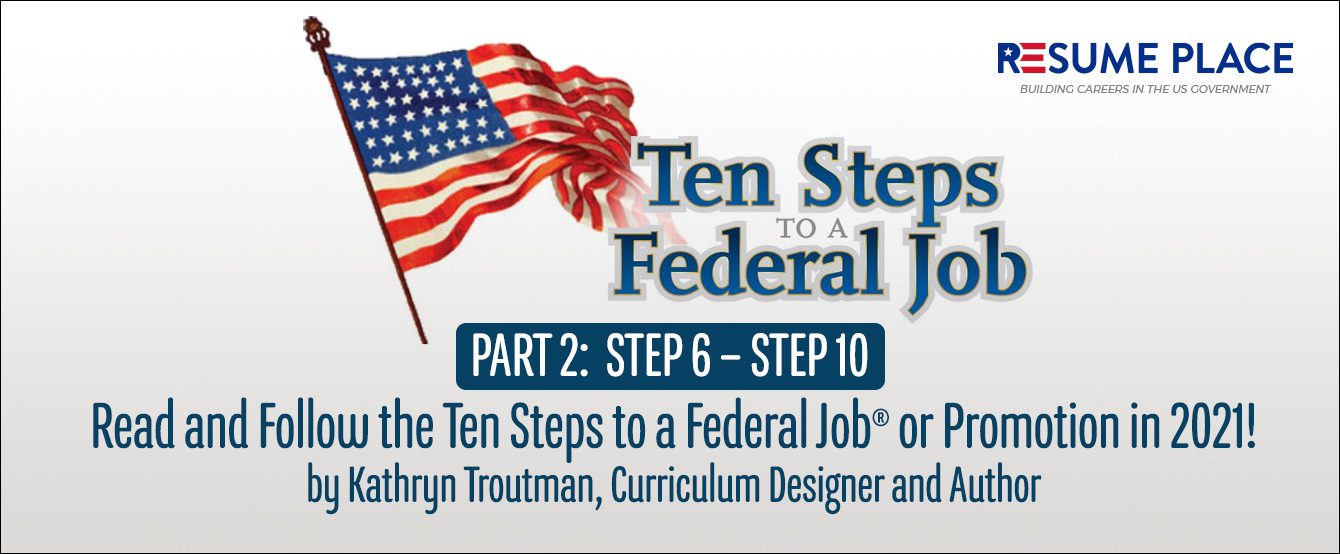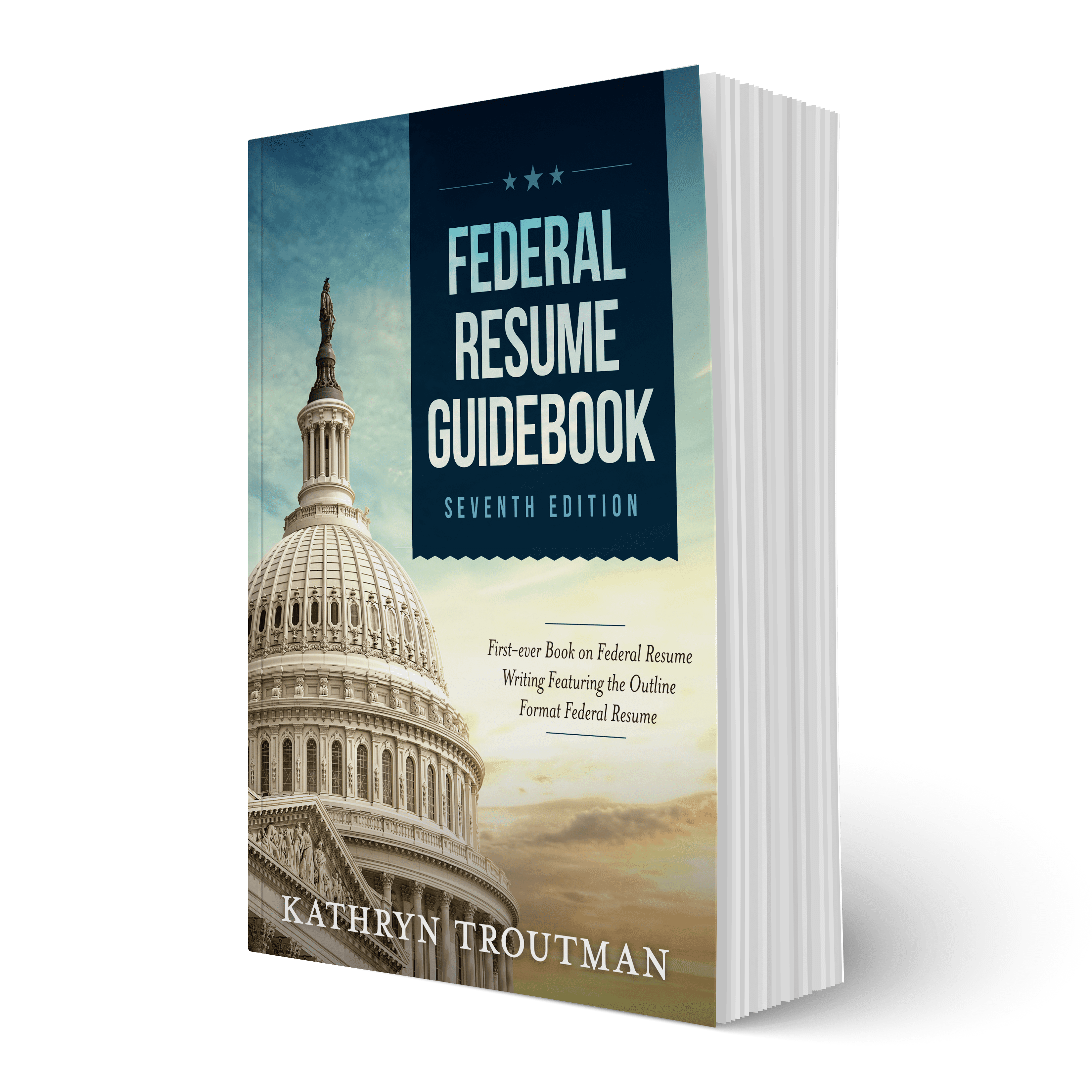Potomac, MD | February 1, 2021
PLEASE NOTE:
FREE TEN STEPS WEBINAR WITH KATHRYN TROUTMAN
SEATS STILL AVAILABLE FOR for Feb 12, 2021, 12 noon to 1 pm ET.
Register here
With the ramping up of the new Biden Administration, it’s time to learn how to apply for federal jobs. Leading federal career coach Kathryn Troutman says, “Any time there’s a new administration, there are a lot of new jobs and new programs.”
Troutman is the creator of a winning formula that you can use to apply to work for the feds. It’s called Ten Steps to a Federal Job.® “Each step is really important in the process,” she explains. “And because each step has its own personality and is very different, it makes the Ten Steps interesting to use for your federal job search.”
The Part 1 press release covered the first five steps: Step 1. Review the Federal Job Process; Step 2. Network—Who Do You Know?; Step 3. Research Vacancy Announcements on USAJOBS; Step 4. Analyze Vacancy Announcements for Keywords; and Step 5. Analyze Your Core Competencies.
This press release (Part 2) presents Steps 6 through 10:
Step 6. Master the Federal Resume. “This is the biggest step,” says Troutman. To begin, know that a federal resume is different than a private industry resume. On average, it’s 5 pages. This allows you to cover the additional details the feds require. Troutman’s Outline Format will help. Its design makes the required specialized experience easy to find by HR. The Duties and Responsibilities section is broken out into small paragraphs of 5-8 lines each. Each paragraph has an ALL CAPS heading matching the keywords. Your current job might be written with 5-6 paragraphs. Hot tip: Include Accomplishments that demonstrate specialized experience. Tip 2: Go to the government’s official website, USAJOBs.gov, and use the builder there to write your first federal resume. “After you build it, use Print Preview to copy it out of the builder and put it in Word at 11 point type,” Troutman advises. “The version printed out of the builder uses too small of a font.”
Step 7. KSAs, Accomplishments, and Questionnaires. Not all announcements on USAJOBs have KSAs (Knowledge, Skills and Abilities statements), but many do. Look here too for keywords and address these requirements in your resume. Good ways to address KSAs are with accomplishments or through keywords in the ALL CAPS lines described in Step 6. Accomplishments are little standout stories—about a problem you solved or a new program you started—that help the resume get Best Qualified and Referred to a supervisor for consideration. The Self-Assessment Questionnaire is a test where you assess your skills for the job. “Because this is a test, give yourself the highest score you can,” says Troutman. “The first cut-off for the application is the questionnaire, and you must score highly to get referred.”
Step 8. Apply for Jobs with USAJOBS. “Like Step 6, this is one of the biggest steps,” notes Troutman. To prepare to apply, look at the bottom of the announcement for required documents. You might need a transcript as a new grad or the DD-214 (Certificate of Release or Discharge) for Veterans Preference. Then, in Part 1, answer the initial personnel questions and set up your profile carefully. Part 1 is also where you load your federal resume. In Part 2, answer more questions and do the Self-Assessment Questionnaire. You’ll also move over your documents, including your resume, to actually apply for the job. Be sure to apply at least a day ahead of any deadline in case of problems. Also, allow at least an hour for the full application process. Finally, be sure to click “Submit My Answers” at the end to actually apply.
Step 9. Track and Follow Up on Your Applications. “The good news is that you can actually track and follow up with your USAJOBs federal application,” Troutman says. “There are three ways.” (1) Through emails from the Office of Personnel Management (OPM). OPM emails may tell you if you are eligible or ineligible, and if you’re are best qualified or referred. (2) Look at your Application Tracking Page in your USAJOBs account. While not always up-to-date, you can often see results on the right side. This includes Received, Application Incomplete, Referred or Selected. (3) Two to three weeks after the position is closed, email the HR person listed on the announcement. Ask about the status of your application. You may discover that you were found ineligible but then prove that your qualifying experience is actually in your resume. Or maybe there were disqualifying mistakes made in applying that you can avoid the next time.
Step 10. Interview for a Federal Job. “Interviewing is another test,” says Troutman. “Again it’s about proving the specialized experience.” The average federal interview is 35 minutes and involves 7-10 questions (most open-ended). It’s important to practice. Troutman recommends going back to the specialized experience, and coming up with questions and answers that support having it. Have stories ready about your relevant accomplishments. Another part of Step 10 is negotiating your job offer. If you’re lucky enough to get an offer, you can ask for a day or two to decide. Go back to the announcement and see if you have superior qualifications. If so, write a letter asking for a step up within the grade level you were offered.
TThe first time Troutman taught the Ten Steps was in 2002 to a group of state unemployment officers in Wheaton, Maryland. “After that workshop, I realized that I needed to come up with a train the trainer program,” recalls Troutman. “That way I could teach more counselors about the federal job search.” Today the Ten Steps is a licensed curriculum taught in at least 500 military bases worldwide and at job centers and universities. It’s also the basis of Troutman’s Federal Job Search Trainer and Federal Career Coach certification program.
“People want to know how to get a federal job, and this is a step-by-step approach through the entire federal application process,” says Troutman. “Get ready… 2021 is going to be a banner year in hiring for federal jobs.”
For more help, see Troutman’s Federal Resume Guidebook, 7th Edition, or consider a $190 consult at Troutman’s Resume Place for feedback on the vacancy announcement you’re considering and how to improve your resume.
Kathryn Troutman is the Founder and President of Resume Place, Inc., a Federal Career Consulting, Publishing and Government Training Business. Her firm specializes in writing and designing professional federal resumes, as well as consulting, coaching and education on the federal hiring process. She is the author of many best-selling federal career books, including the Federal Resume Guidebook, 7th Ed.

The Official Hiring Website of the United States Government: USAJOBS.gov
Troutman’s Resume Place offers a consultation to see if the vacancy announcement you picked is right for you, and to make sure you’re covering the needed qualifications in your federal resume.
Resume Place’s Federal Career Consulting and Presidential Appointee Consulting
More info here
For examples of federal resumes, see Troutman’s Federal Resume Guidebook, 7th Ed.
More info here









